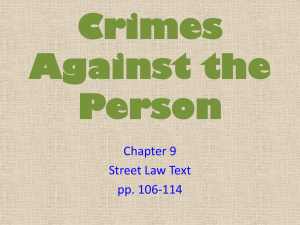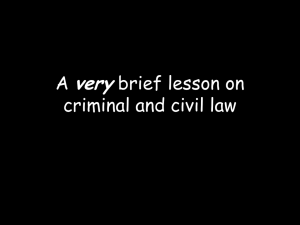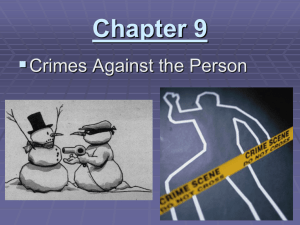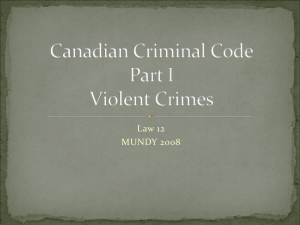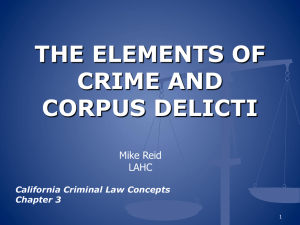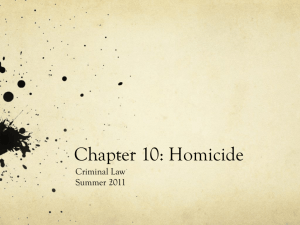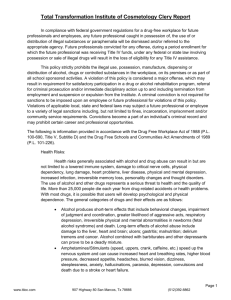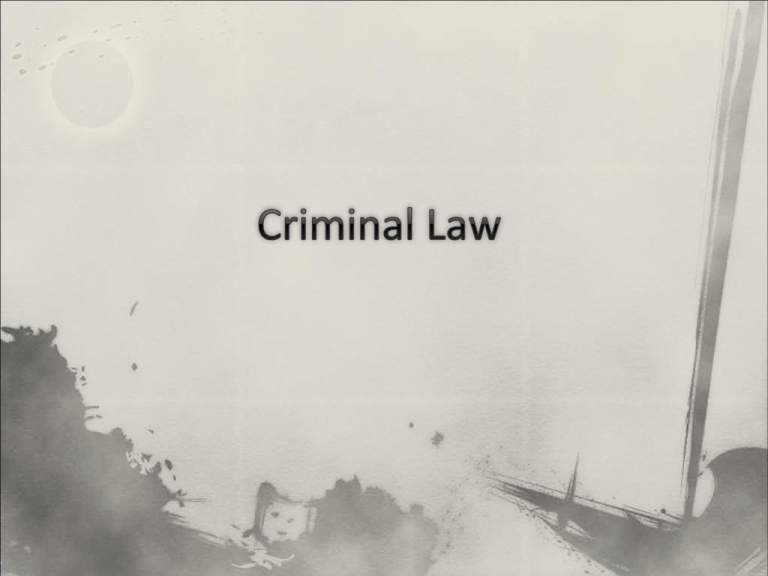
Substantive criminal law defines what types of
conduct are criminal and prescribes the penalties to
be imposed for engagement in that conduct.
Procedural criminal law involves the rules designed
to implement the substantive law. It is concerned
with the criminal process, the legal steps through
which an accused offender passes.
Sumerian Codes (3500 BC)
Codes of Hammurabi (2000 BC)
Egyptian laws
Hebrew Law
Greco/Roman Law (Justinian I – 534 AD
Medieval Era
Magna Carta (1215 AD)
U.S. Constitution
State Constitutions
Federal, State, County, City Laws/Codes
Federal, State, County, City Regulatory Agency
Rules and Regulations
Executive Orders
Federal and State Court Decisions
A crime is an act or an omission prohibited
by law, the violation of which is prosecuted
by the state in a judicial proceeding in its
own name. It is a public wrong as
distinguished from a private wrong.
5%
20%
Shred
Reasonable
Suspicion
33%
Probable
Cause
51%
Preponderance
67%
Clear &
Convincing
90%
Beyond
Reasonable
Doubt
Actus Reus
Commission – movement, verbal,
possession
2. Omission – failure to act when had a legal duty to
do so
(Writ of demurrer)
1.
Mens rea (intent)
Reasonable Man Test
Lowest
General
Negligence
Highest
Recklessness
General
Intent
Specific
Malice
Premeditation
Insanity – lacks the capacity to appreciate the
wrongfullness of their conduct.
Under the influence – vountariness is the key
An individual is not liable in a criminal court
for remote, unforseeable, or indirect
consequences which a reasonable person
would not have foreseen as likely to have
flowed from the act. There is a liability for the
direct results of the act, but a diminished/no
criminal liability for remote, unforseeable, or
indirect consequences.
Criminal Law
Civil Law
Public offense
Punishment
State brings the action
Limited state appeals
Fine goes to the state
Beyond Reasonable Doubt
Reasonable Man Test
Higher levels of intent
Unanimous jury
Private wrong
Monetary damages
Individual brings the action
Both parties can appeal
Individual compensation
Preponderance
No Reasonable Man Test
Lower levels of intent
Non-unanimous jury
The killing of a human being, caused by the act of another.
Justifiable
A - Court order:
1 - execution
2 - hospital/comatose situation
B - Necessary to suppress a legally defined riot setting.
C - Necessary when law enforcement agents are dealing with a felon.
D - Necessary when in defense of self or others. When you or a
member of your party face a real and immanent threat of
death or serious injury, deadly force may be utilized in a
justifiable manner and no criminal liability will be
forthcoming.
E - Necessary when protecting your personal property (Make
My Day Laws)
The killing of a human being, caused by the act of another.
Excusable
A - By an individual incapable of crime (account of 2 or 3 year
old who pounded nail in ear of his 4 or 5 day old sister)
B - Result of an accident or mistake as a result of ordinary
negligence
Homicide that was neither justifiable nor
excusable.
- First degree murder (premeditation)
- Second degree murder (malice)
- Voluntary manslaughter (general intent)
- Involuntary manslaughter (recklessness)
- Statutory manslaughter (general negligence)
Any death which occurs during the commission of a felony can be
considered murder (usually 1st degree murder), and all participants in
that felony or attempted felony can be so charged as long as there is a
causal connection between the felony and the killing (proximate cause).
This rule broadens the crime of murder in two ways:
Even if there was no intent to kill, if a death occurs during the
commission or attempted commission of a felony, murder can be
charged as long as there is a causal connection between the felony
and the killing (proximate cause).
All participants in the felony can be held equally culpable, including
those who did no harm, possessed no weapon, and did not intend to
hurt anyone.
Any un-consented touching of another, no matter
how slight the injury.
-
Knowledge of the victim is essential
Words are sufficient – the accused’s conduct
must have created an apprehension of
immediate un-consented touching
-
Simple assault
Aggravated assault
Verbal assault
Assault with a dangerous weapon
Assault with a deadly weapon
Assault on a law enforcement officer
Stalking
Domestic assault
Sexual assault
Sexual assault (traditional definition) – the
unlawful carnal knowledge of a woman by
force without consent.
1. No spousal exemption.
2. Spousal exemption only if living apart under
or pursuant to a court order of divorce.
3. Blanket spousal exemption.
The slightest sexual penetration of intimate
parts is sufficient to constitute a crime.
Most states have scaled out sexual assault
along a gradient from level 1 (un-consented
kissing) up to step 7 (sexual intercourse).
No longer. Men may now be raped (gender
neutral).
Done generally in response to homosexual
scenarios.
What is force? Must the victim physically
resist?
What is consent? Can there be any level of
victim precipitation? If there is, is there a
mitigating level of criminal liability on the part
of the assailant?
Few cases are reported to the police. Officially there
are 100,000 cases reported each year, but the actual
number is likely closer to 3 million – 4 million.
Around 5% of cases reported are total fabrications.
An unknown number of cases involve a rape that has
actually occurred and a purposeful false
indentification of an offender by the victim.
Non-chastity of a woman is not a defense
Courtroom paradox
Rape Shield laws
Post sexual assault, assaults
Hollywood vs reality
Statutory Rape
Incest
Traditional Male Sex Crimes
Prostitution
Obscenity
Child Sexual Abuse
There is no firm definition, but in general, it
is carnal knowledge of an individual under a
designated age by someone who is over a
designated age. Generically speaking of
adults who engage in sexual activities with
children, but, the legal definitions of “adult”
and “child” in this context are somewhat
asymmetric.
Megan’s Law (SORIS)
Human trafficking
20 million worldwide
8 million in sex trade
1.8 million children in sex trade
Protect Act
Extra-territoriality
Robbery – the taking and carrying away of the
property of another, by force or the threat
thereof; involves a fear factor
Simple “robbery”
Armed robbery (aggravated robbery)
Robbery with a dangerous weapon
Robbery with a deadly weapon
Bank robbery (typically a federal offense)
Burglary – the breaking and entering into the
dwelling of another with the intent to commit
a felony
Larceny/Theft – the taking and carrying away of the
property of another by one who has no right to
possession and/or ownership (intent is permanent
deprivation of ownership); it is a trespass against the
possession of another.
Grand theft
Petty theft
Shoplifting
Auto theft
Embezzlement (taking by one already in lawful
possession; it is a trespass against the ownership, rather
than the possession of, another)
Planned bankruptcy
Savings and Loan scams
Check kiting
Stock and bond fraud
Land fraud
Oil fraud
Tax fraud
Health care fraud
Price fixing and bid rigging
Illegal campaign contributions
Computer fraud
Communications fraud
Identity theft
Corporate Crime
Bid rigging/price fixing
Sale of defective merchandise
Dumping of defective merchandise
Illegal disposal (dumping) of toxic products
Hazardous working conditions
Filing false financial reports
Governmental Misconduct (white collar and beyond)
Watergate
Iran/Contra
Guantanamo/Abu Ghriab
Genocides
Arson
Forgery
Counterfeiting products
Art crime
Receiving stolen property
Governmental Misconduct (white collar and beyond)
Watergate
Iran/Contra
Guantanamo/Abu Ghraib
Genocides
Carrying a concealed weapon
Minors in possession of weapons
Possessing a weapon (D.C. v Heller)
Waiting periods
Restrictions
Registration
Permits and licenses
Bans
Theft of services
Kidnapping/False imprisonment
Traffic violations
Bribery (offering or accepting a bribe)
the offer of anything of value to any person holding
public office with the intent of influencing the official
performance of their duty
the receipt of anything of value by a public official
with the intent of being influenced in the official
performance of their duty (what is lobbying?)
It is a crime to knowingly and intentionally
possess and/or distribute controlled substances
with authorization. The big four at present are:
-marijuana
- cocaine/crack
- methamphetamines
- heroin
- LSD
- Ecstasy
- GHB
- Dilaudid
- Bufotenine
- Ritalin
- Rohypnol
- Ketamine/Special K
- Oxycontin (percocet/percodan)
- Vicodin
- Cheese (3% heroin and cold medication)
- Khat
- Salvia/Sally D
Tobacco (45 M deaths in U.S. by 2100; 1 B deaths worldwide)
Purchase underage
Provide to a minor
Smoke in public places
Tax avoidance
Alcohol (10 M deaths in U.S. by 2100)
Purchase underage
Possess underage
Provide to a minor/contributing to the delinquency of a minor
Public intoxication
Tax avoidance
DWI
If you wish to break the law with impunity, become the law (Hitler, Stalin,
Marcos, etc).
Those who make the laws are far more dangerous to us than those we lock away.
The great criminals we know of are the major corporations and their governmental
partners who, in collusion, pass laws to make their illicit behaviors legal.
We receive law enforcement attention in inverse proportion to our power and
influence.
“All governments that have flourished since the beginning of time have been
nothing more than a conspiracy of the rich to perpetuate themselves under the
guise of statecraft.”
Thomas More
“Anything that is economically right, is morally right.”
Henry Ford
Role model theory and the market economy (C. Wright Mills)
Money is the measure of self-worth.
Money gives the power to change reality.
Money brings a measure of immunity from wrongdoing.
Unto those who acquire, less is required.
Definitions of crime (which are controlled by the elite),
provide an ideology to justify their retention of
power/the status quo.
The focus on street crime deflects attention away from
the more serious crimes.
Our behaviors tend to reflect those in the higher social
strata.


